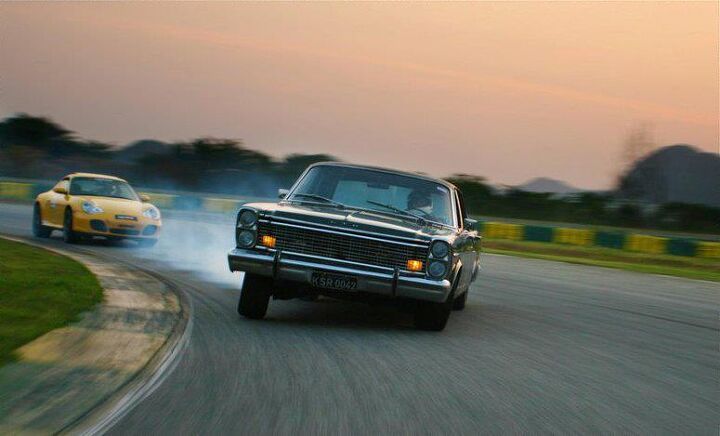Piston Slap: What Makes a Bad Suspension?

TTAC commentator Seminole95 writes:
Sajeev,
The Wall Street Journal recently suggested that part of VW’s problem in the US is the slow growth in Passat sales. About the Passat sales, they attribute it to a cheapening of the components relative to the European Passat, stating: “The American model also got a simpler, lower-cost suspension that delivered a less precise ride.”
My question is: how does one tell a priori that they are buying a car with a cheap suspension? Many mainstream media car reviews do not discuss the objective quality and construction of suspension components, preferring to discuss subjective feelings of ride. In addition, a car’s ride may “feel” good now, but this does not mean that it will in 5 years.
As an aside, one of the reasons I am interested is, I am thinking about buying the new Honda Accord and trading in my old one. But the new Accords have the MacPherson struts whereas the old ones had a double wishbone setup.
Thank you, TTAC, and your readers for intelligent car discussion.
Sajeev answers:
Ya know, autojournalism is a tough gig: explain why you feel a certain way and you bore people with engineering jargon. Well, that’s provided you actually have to chops to explain why a certain design/component behaves a certain way in the first place! But I digress…let’s begin with some salient points:
- Some suspension designs are better than others, depending on application. Sports cars shouldn’t have leaf springs (please accept my apology, Morgan) but I seriously doubt I’d ever want a truck without them (sorry RAM).
- The quality of suspension components makes all the difference in the world. To wit, upgrading shocks (Konis, Bilsteins, etc.) on a seemingly terrible suspension can, by magic, make it the best in its class.
- Mainstream Auto Journalism or no, opinions on this subject are mostly subjective…if not entirely subjective!
Shall you feel a big difference between a new Honda Accord and the older models with double wishbones? Possibly, but that could be attributed to a host of suspension and chassis changes, not the original design. Don’t believe me? Just look at what BMW’s done in terms of suspension feel utilizing this same McPherson strut template.
Now about the Passat: the 2014 model (at least) has a fully independent suspension on all trim levels. Even the base model Jetta, according to the website, regained complete independence from solid axles. But let’s say you like the Toyota Corolla or Ford Mustang: is your ass critically fine tuned enough and do you even care on those rare occasions when a modern solid axle vehicle feels juuuust a little wonky on a curvy+bumpy road?
We all aren’t a Jack Baruth on track…and hell, even Jack Baruth drives a Lincoln Town Car with a watt’s link solid axle on the street, son!
So this is much ado about nothing! My bigger concern is the quality/configuration/durability of the suspension components, not their basic design. Sloppy tuned shocks, poorly sized sway bars, defective ball joints, etc. are a bigger concern. And none of that can be addressed at the time of purchase, sadly.
Send your queries to sajeev@thetruthaboutcars.com. Spare no details and ask for a speedy resolution if you’re in a hurry…but be realistic, and use your make/model specific forums instead of TTAC for more timely advice.

More by Sajeev Mehta
Latest Car Reviews
Read moreLatest Product Reviews
Read moreRecent Comments
- Zipper69 A Mini should have 2 doors and 4 cylinders and tires the size of dinner plates.All else is puffery.
- Theflyersfan Just in time for the weekend!!! Usual suspects A: All EVs are evil golf carts, spewing nothing but virtue signaling about saving the earth, all the while hacking the limbs off of small kids in Africa, money losing pits of despair that no buyer would ever need and anyone that buys one is a raging moron with no brains and the automakers who make them want to go bankrupt.(Source: all of the comments on every EV article here posted over the years)Usual suspects B: All EVs are powered by unicorns and lollypops with no pollution, drive like dreams, all drivers don't mind stopping for hours on end, eating trays of fast food at every rest stop waiting for charges, save the world by using no gas and batteries are friendly to everyone, bugs included. Everyone should torch their ICE cars now and buy a Tesla or Bolt post haste.(Source: all of the comments on every EV article here posted over the years)Or those in the middle: Maybe one of these days, when the charging infrastructure is better, or there are more options that don't cost as much, one will be considered as part of a rational decision based on driving needs, purchasing costs environmental impact, total cost of ownership, and ease of charging.(Source: many on this site who don't jump on TTAC the split second an EV article appears and lives to trash everyone who is a fan of EVs.)
- The Oracle Some commenters have since passed away when this series got started.
- The Oracle Honda is generally conservative yet persistent, this will work in one form or fashion.
- Theflyersfan I love this car. I want this car. No digital crap, takes skill to drive, beat it up, keep on going.However, I just looked up the cost of transmission replacement:$16,999 before labor. That's the price for an OEM Mitsubishi SST. Wow. It's obvious from reading everything the seller has done, he has put a lot of time, energy, and love into this car, but it's understandable that $17,000 before labor, tax, and fees is a bridge too far. And no one wants to see this car end up in a junkyard. The last excellent Mitsubishi before telling Subaru that they give up. And the rear facing car seat in the back - it's not every day you see that in an Evo! Get the kid to daycare in record time! Comments are reading that the price is best offer. It's been a while since Tim put something up that had me really thinking about it, even something over 1,000 miles away. But I've loved the Evo for a long time... And if you're going to scratch out the front plate image, you might want to do the rear one as well!


































Comments
Join the conversation
Different strokes for different folks. Just make sure your test drives are thorough and you'll weed out the stuff you don't like.
How do we determine quantitatively, what a bad suspension is? Everyone can always have an opinion, but numbers would let us know if our impressions are right, and to what degree. We certainly have two major ways to measure horizontal cornering performance: skid-pad and slalom. But what about "vertical performance", which we commonly call ride quality? How to measure that? Well, if some sort of accelerometer (like a seismometer for earthquakes) where attached to the following places on a car, it would do just that: 1) The lower suspension arm, where it is attached to the wheel; 2) The floor on the passenger's side (or a side panel on the car); 3) The passenger's seat itself, on the cushion. It should not take too much guessing to see that the first tells you what the suspension has to deal with; the second tells you what the car has to deal with; and the third tells you what the human has to deal with. Some of the motion-vs.-time traces, their maxima, and their slopes, could be quantified for measurements in all three cases. But what about standard test roads specific for this ride quality? I could suggest three things: 1) A straight smooth concrete road with 1/2-inch high by 1-inch wide metal bars going straight across it, separated by 20 feet. There could be 10 such bars. These would simulate severe expansion joint or tar-strip conditions on real roads; 2) A straight smooth concrete road with 2-inch deep by 1-foot long metal trenches or troughs embedded into the concrete, running half-way across the road, but then staggered with another trench coming from the other side. Each half-trench could be separated by 20 feet. This would be meant to measure, not surprisingly, pot holes (mild ones at that!). 3) An undulating straight road surface with sinusoidal "waves" that are perhaps 3 inches high and have a wavelength of 10 feet. 10 such cycles could be molded as concrete into the concrete road. These would measure the ability of the vehicle to handle larger scale, uneven road surfaces; Perhaps the testing could be done for: 1) City speeds, say about 30 mph; 2) Back-road highway speeds, say about 60 mph. Anyone have any feelings on this idea? --------------------